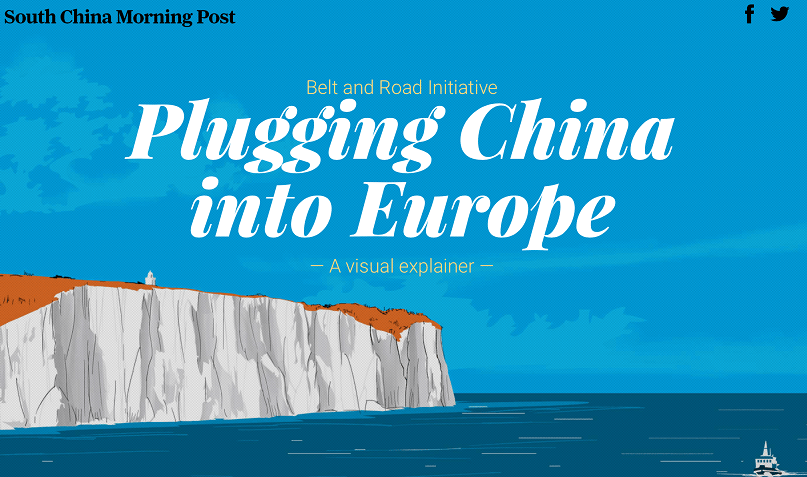Plugging China Into Europe via OBOR – A Summary
Hats off to Hong Kong’s South China Morning Post for producing one of the coolest multimedia presentations on how China will reach Europe across Eurasia via rail. This excellent graphic shows the route from China moving across Mongolia, Central Asia, and Russia, passing through Eastern Europe before terminating in London. It is well worth a look, although there are other routes, as we have explained previously on this website, that reach further south into the EU.
There has been a great deal of misunderstanding about the financial viability of overland rail compared with shipping. However, rail transportation allows items to be carried over shorter land distances, and is faster, which is preferable for perishable and other items. Rail is also suitable for getting heavy duty equipment into remote land areas – which is exactly what is required to develop parts of the more inaccessible Silk Road regions, and especially in Central Asia.
This, therefore, is as good a point as any to provide a summary of developments along the overland rail routes in terms of the actual hardware, development plans, new routes, furtherance of free trade, and the ultimate impact of the upcoming 5G digital economy – as well as what China really wants to achieve from all this.
Beginning with China, the rail traffic between China, Mongolia, and Russia increased by 150 percent year-on-year. China is also working with the Trans-Siberian nations and the EU to provide rail container standardization across Eurasia – an important issue when track widths and bogies differ in sizes between China, Russia, and the EU. China has also been developing track-changing trains to deal with the issue.
A larger part of the route to Europe includes Russia of course, and both China and Russia have announced they will commence High-Speed Rail Freight from 2019. There are also discussions taking place that may see a high-speed passenger service take on the entire Trans-Siberian route from Moscow to Beijing, while India and Iran are also getting in on the act by agreeing with Russian plans for the International North-South Corridor that links both nations through to Russia and the Trans-Siberian routes west to Europe and east to China.
Eastern Europe, however, needs to up its game in terms of compatibility, a factor the Chinese have noticed and consequently formed the 16+1 grouping to discuss and formulate. This includes Chinese plans to invest in numerous projects in Eastern Europe, not just in rail but also to accelerate the need to build improved rail and trade connectivity with Eastern Europe. This also impacts the entire EU with digital connectivity, where we summarized the current state of affairs in the digital economy and 5G technologies as are being developed across China and the EU. Russia, too, has been targeting and heavily investing in digital technologies and to date is also ahead of most of the EU is this regard. Cities such as Moscow and St. Petersburg are rolling out 5G at next year’s world cup soccer finals, while nations such as Germany appear to be five-seven years behind.
In terms of trade, the demise of the TPP and the rise of OBOR has given extra impetus and importance to the Eurasian Economic Union (EAEU), a free trade bloc that multiple nations, including China and India are clamoring to negotiate Free Trade Agreements with. Iran is about to sign an FTA with the EAEU and other nations as mentioned are keen to follow.
Should China successfully negotiate a Free Trade Agreement with the EAEU, that would effectively bring Chinese goods right up to the European Union’s borders. The idea of Eurasian Free Trade may be expanded further, Russia and China are both examining the potential for a “Greater Eurasian Partnership“ that would conceivably include not just the EAEU, but the members of the Shanghai Co-Operation Organisation and ASEAN.
In total contrast to the United States and an increasingly tardy EU, China has been pro-active in negotiating Free Trade Agreements all along the OBOR routes, and are now examining which EU nations are best positioned to take advantage of new trade not just of goods, but the new levels of service and operations that will go hand in hand. Estonia is a good example. Other EU Nations need to catch up or may find their own business platforms rendered redundant, and fast.
This leads us further into the EU, where a breakdown of China’s European Freight Rail Terminals can be found here, and a summary of how the UK, the final destination on the South China Morning Posts excellent graphic can benefit here.
There is no doubt that China is serious about its intentions. However it is not all about getting Chinese goods into European markets. As a One-Party State, the Communist Party of China is well aware it has to deliver to its own population. Not being able to do so has extreme consequences when it is not possible to vote in an alternative government. China’s development of the Eurasian Rail network is rather more about transporting to China according to what it needs. These are the main takeaways:
- China has 20 percent of the global population but just five percent of globally available arable land.
- China’s energy needs grew 146 percent in the last decade. The EU’s growth during the same period was seven percent.
- China’s middle class consumer base will reach 500 million by 2020, and is already larger than that of the EU.
- The number of Chinese consumers able to purchase online is currently one billion, 25 percent larger than the total population of the EU.
- China needs food, energy, and smart, safe EU products and consumables.
In summary, the Eurasian Rail network is principally important because it allows China to access what it needs. Rather than take the view of trains full of cheap plastic products flooding EU markets, European businesses and governments ought to look at ways for their own economies, services, and manufacturing industries to adapt. It is happening, in every sphere from hardware to tax and free trade. How prepared is your business economic and technological development?
About Us
Chris Devonshire-Ellis is the Founding Partner and Chairman of Dezan Shira & Associates. He is based in Europe. The firm provides European businesses and governments with strategic, legal, tax and operational advisory services to SMEs and MNCs investing throughout Asia and has 28 offices across China, India and the ASEAN nations as well as St. Petersburg and Moscow. Please contact the firm at asia@dezshira.com or visit the practice at www.dezshira.com
 Related Reading:
Related Reading:
Silk Road and OBOR Business Intelligence
Dezan Shira & Associates´ Silk Road and OBOR investment brochure offers an introduction to the region and an overview of the services provided by the firm. It is Dezan Shira´s mission to guide investors through the Silk Road´s complex regulatory environment and assist with all aspects of establishing, maintaining and growing business operations in the region.
DSA 2017 Doing Business In China
Doing Business in China 2017 is designed to introduce the fundamentals of investing in China. Compiled by the professionals at Dezan Shira & Associates in January 2017, this comprehensive guide is ideal not only for businesses looking to enter the Chinese market, but also for companies who already have a presence here and want to keep up-to-date with the most recent and relevant policy changes.
Establishing a Foreign Business in Russia
In this issue of Russia Briefing, we explain the basics of business set up for foreign investors, from trademark registration, representation, trading mechanisms, and manufacturing. With low corporate tax rates, Russia is set to become the most dynamic of the trade corridors opening up to Asia.
China’s New Economic Silk Road
This unique and currently only available study into the proposed Silk Road Economic Belt examines the institutional, financial and infrastructure projects that are currently underway and in the planning stage across the entire region. Covering over 60 countries, this book explores the regional reforms, potential problems, opportunities and longer term impact that the Silk Road will have upon Asia, Africa, the Middle East, Europe and the United States.











